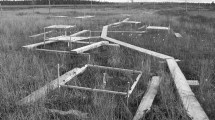Summary
Chlorophyll distribution within the carpets, CO2 gas exchange under controlled conditions, and heat resistance of the snowbed bryophyte Anthelia juratzkana (Limpr.) Trev. were investigated. Also the gas-exchange parameters of the co-occurring Polytrichum sexangulare Floercke were assessed. Only the uppermost 4 mm layer of Anthelia carpets contains sufficient pigments for photosynthesis. At light saturation and optimal temperatures (6–11°C) the maximum rates of CO2 uptake are 0.7 mg CO2 g-1dw h-1 in Anthelia and 1.5 mg CO2 g-1dw h-1 in Polytrichum. Gas exchange reaches light saturation at about 300 μE m-2s-1 in both species. At +2°C the light compensation point is reached at ca. 10μE m-2s-1 and increases significantly with increasing temperature. The lower temperature compensation point is reached at-4°C in Anthelia and does not drop much below-5°C in Polytrichum. Anthelia cannot sustain net photosynthesis beyond 30°C and Polytrichum not beyond 32°C. Nine month storage under dark, cold and wet conditions does not affect the photosynthetic capability of Anthelia. As a response, however, the net photosynthesis rate is depressed due to an increase of the respiration rates. Polytrichum sexangulare did not tolerate the storage so well. The heat resistance limit of Anthelia is low (39°C). There is evidence that the distribution of the two bryophytes within snowbed communities is determined by their capability to make use of low light intensities and their low temperature demand for optimal photosynthetic rates. Being resistant to long lasting cold, wet, and dark conditions, Anthelia is particularly adapted to grow in the border zone along permanent snowpatches. Polytrichum is more productive and is therefore capable of competing successfully at sites which are less extreme and therefore accessible for higher plants.
Similar content being viewed by others
References
Arnon DI (1949) Copper enzymes in isolated chloroplasts. Polyphenoloxidase in Beta vulgaris. Plant Physiol 24:1–15
Biebl R (1968) Über Wärmehaushalt und Temperaturresistenz arktischer Pflanzen in Westgrönland. Flora (Jena) Abt B 157:327–354
Billings WD (1974) Arctic and alpine vegetation: plant adaptations to cold summer climates. In: Ives JD, Barry RG (eds) Arctic and alpine environments. Methuen, London, pp 403–443
Blum A, Ebercon A (1981) Cell membrane stability as a measure of drought and heat tolerance in wheat. Crop Sci 21:43–47
Dahl E (1956) Rondane, mountain vegetation in south Norway and its relation to the environment Norske Videnskap-Akademie, Oslo (Skrifter I. Mat Naturv Klasse, 3)
Dilks TJK, Proctor MCF (1975) Comparative experiments on temperature responses of bryophytes: assimilation, respiration and freezing damage. J Bryol 8:317–336
Ellenberg H (1978) Vegetation Mitteleuropas mit den Alpen. Einführung in die Phytologie IV 2, Ulmer, Stuttgart
Franz H (1979) Ökologie der Hochgebirge. Ulmer, Stuttgart
Geiger R (1961) Das Klima der bodennahen Luftschicht, 4. Aufl. Vieweg, Braunschweig
Gjaerevoll O (1949) Snøleievegetasjonen i Oviksfjellene. Acta Phytogeogr Suec. 25:1–106
Gjaerevoll O (1950) The snow-bed vegetation in the surroundings of Lake Torneträsk, Swedish Lappland. Svensk Bot Tidskr 44: 387–440
Huneck S, Vevle O (1970) (-) 16 α-Hydroxykauran aus Anthelia julacea (L) Dum. und Anthelia juratzkana (Limpr.) Trev. Z Naturforsch Teil B 25:227
Kallio P, Kärenlampi L (1975) Photosynthesis in mosses and lichens. In: Coper JP (ed) Photosynthesis and productivity in different environments, IBP 3. Cambridge University Press, Cambridge, pp 393–423
Kappen L (1964) Untesuchungen über den Jahreslauf der Frost-, Hitze- und Austrocknungsresistenz von Sporophyten einheimischer Polypodiaceen (Filicinae). Flora (Jena) 155:123–166
Kappen L (1981) Ecological significance of resistance to high temperature. In: Lange OL, Nobel PS, Osmond CB, Ziegler H (eds) Physiological plant ecology I. Springer, Berlin Heidelberg New York (Encyclopedia of plant physiology, NS, vol 12A. pp 439–474)
Miller PC, Oechel WC, Stoner WA, Sveinbjörnsson B (1978) Simulation of CO2 uptake and water relations of four arctic bryophytes at Point Barrow. Photosynthetica 12:7–20
Müller K (1912/16) Die Lebermoose Deutschlands, Österreichs und der Schweiz. In: Rabenhorst L (Hrsg) Kryptogamenflora von Deutschland, Österreich und der Schweiz, 2. Aufl. Kummer, Leipzig
Oechel WC, Collins NJ (1976) Comparative CO2 exchange patterns in mosses from two tundra habitats at Barrow, Alaska. Can J Bot 54:1355–1369
Pisek A, Larcher W, Unterholzner R (1967) Kardinale Temperaturbereiche der Photosynthese und Grenztemperaturen des Lebens der Blätter verschiedener Spermatophyten. I. Temperaturminimum der Nettoassimilation, Gefrier-und Frostschadensbereiche der Blätter. Flora (Jena) Abt B 157:239–264
Rastorfer JR (1972) Comparative physiology of four west Antarctic mosses. In: Llano GA (ed) Antarctic terrestrial biology. American Geophysical Union, Washington (Antarctic Res Ser vol 20) pp 143–161
Riedl H (1977) Micro-biocoenosis of Anthelia juratzkana. Bryologist 80:332–334
Scidel D (1976) Experimentell-ökologische Untersuchungen an Waldbodenmoosen als Grundlage einer kausalanalytischen Interpretation synökologischer Aspekte. Flora (Jena) 165:163–196
Skartveit A, Rydén BE, Kärenlampi L (1975) Climate and hydrology of some Fennoscandian tundra ecosystems In: Wielgolaski FE (ed) Fennoscandian tundra ecosystems, pt 1: Plants and microorganisms. Springer, Berlin Heidelberg New York (Ecological studies 16) pp 41–53
Walter H (1968) Die Vegetation der Erde in öko-physiologischer Betrachtung, Bd 2: Die gemäßigten und arktischen Zonen, 3. Aufl. Fischer, Stuttgart
Warren-Wilson J (1957) Observations on the temperatures of arctic plants and their environment. J Ecol 45:449–531
Author information
Authors and Affiliations
Rights and permissions
About this article
Cite this article
Lösch, R., Kappen, L. & Wolf, A. Productivity and temperature biology of two snowbed bryophytes. Polar Biol 1, 243–248 (1983). https://doi.org/10.1007/BF00443195
Received:
Accepted:
Issue Date:
DOI: https://doi.org/10.1007/BF00443195




